Join Chalkbeat New York’s free every day e-newsletter to get important information about NYC’s public colleges delivered to your inbox.
A candy odor wafted by means of a classroom of second and third graders as a pair of scholars in pink aprons measured oats for a granola recipe.
Subsequent door, a bunch of fourth and fifth graders peeled garlic cloves to make recent garlic bread.
It was simply one other Tuesday at Central Park East 1 elementary faculty, the place each classroom is provided with an oven and fridge, and each day college students prepare dinner or bake a snack as a part of their many routines.
Deborah Meier based the college 50 years in the past with a mission: to construct a democratic academic mannequin the place academics collaborate to construct their very own curriculum rooted in hands-on, project-based studying; dad and mom have a voice of their kids’s schooling; and kids have ample decisions throughout their every day “work” or “mission” time.
Central Park East spawned a motion of progressive schooling in New York Metropolis and past, and Meier received a MacArthur “genius” award in 1987 for her work. The college’s child-centered mannequin, following the place college students’ pursuits take them, is dealing with some headwinds at a time when the nation’s largest faculty system is leaning on curriculum mandates and data-driven assessments.
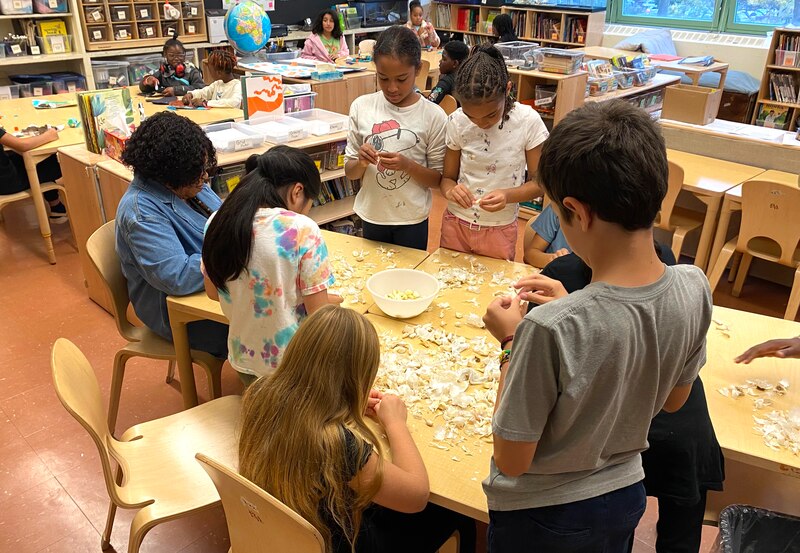
“They mandate every thing: how a lot time you spend on one thing, the way you ask your questions. It’s completely solely towards what good studying is about,” Meier instructed Chalkbeat. “What’s necessary is to concentrate to what’s working with every little one.”
Choices on the small faculty, in some ways, really feel extra like a personal faculty, Meier stated — together with the dearth of emphasis on standardized testing. Children carry again supplies from their common Central Park outings to make use of for artwork tasks and different investigations. They go ice skating weekly. They’ve Monday morning all-school sing-alongs. And there’s an annual tenting journey for fourth and fifth graders, a lot of whom have by no means spent the night time away from their households. College students name their academics by their first names, and the lessons are blended ages (aside from prekindergarten), with college students usually staying with the identical academics for 2 years. The blended lessons push the youthful youngsters up, in some methods accelerating their studying, whereas giving the older youngsters management alternatives, households stated.
Regardless of the curriculum mandates and elevated concentrate on testing systemwide, the college is staying true to its beliefs, with educators and households dedicated to persevering with its legacy.
A letter to households posted final spring on the college’s web site defined how CPE1 would this 12 months be required to implement Into Studying, certainly one of three literacy curriculums mandated citywide. The college deliberate to mix the “finest” of Into Studying with materials “we predict will serve our neighborhood,” the letter defined, praising the curriculum for having a Spanish-language model however critiquing its omission of LGBTQ voices and the way it tackles bias and prejudice. (In Florida, the place the curriculum can also be used, elementary colleges can’t educate about gender or sexual orientation, the letter defined.)
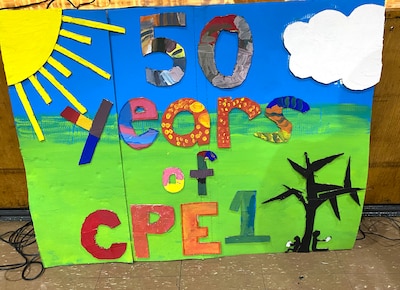
Gabriel Feldberg, CPE1’s principal for the previous eight years, declined to touch upon the letter, however he famous that CPE1’s college students are excessive performers relating to the Acadience assessments college students are given 3 times a 12 months, with greater than 21 out of 24 of the college’s second graders at present studying on or above grade degree.
“Our studying is within the service of our wider academic mission, not within the pursuit of any exterior objectives,” stated Feldberg.
Instances had been totally different when Meier opened the college.
“She did her work at a time when her district and her metropolis valued the form of work she did and was very public about what was fantastic about it,” Feldberg stated. “Information-driven imperatives have modified how we outline high quality in schooling.”
For Meier, schooling ought to assist kids change into “residents of the world” and lively contributors in democracy, she instructed an viewers of scholars, alumni, and former staffers at an October occasion celebrating the college’s fiftieth anniversary. To take part in democracy, youngsters have to expertise dwelling in a single, stated Meier, who at 93 is at present fundraising for a documentary concerning the first graduating class of the East Harlem secondary faculty she opened and the way they embodied the democratic beliefs she sought to create.
“It’s one of many elementary issues that we hoped that colleges may very well be: locations the place kids realized alongside with their academics and their households,” she stated, “and have a say, have a voice that issues.”
Instructing about identification and race by means of self-portraits
When CPE1 opened its doorways in 1974, it served primarily Black and Latino college students from low-income households who had been typically written off by many educators, Meier stated.
“Colleges of schooling throughout my time would say issues like, ‘Black kids don’t have any language after they come to high school,” Meier stated. “Children have a tough time studying from individuals who disrespected them and their households.”
The college’s demographics have shifted since then, however the variety of its workers and pupil physique has change into certainly one of its hallmarks. Roughly 44% of its college students are Latino college students, 25% are white, 15% are Black, and eight% are Asian American — which is extra built-in than most New York Metropolis public colleges. About half of its college students are from low-income households, which is lower than the citywide common of 75%.
The college emphasizes identification, with college students making a sequence of self-portraits every year that cling in school rooms and the hallways.
“We’re very specific about speaking about identification but additionally about race and racism,” Feldberg stated.
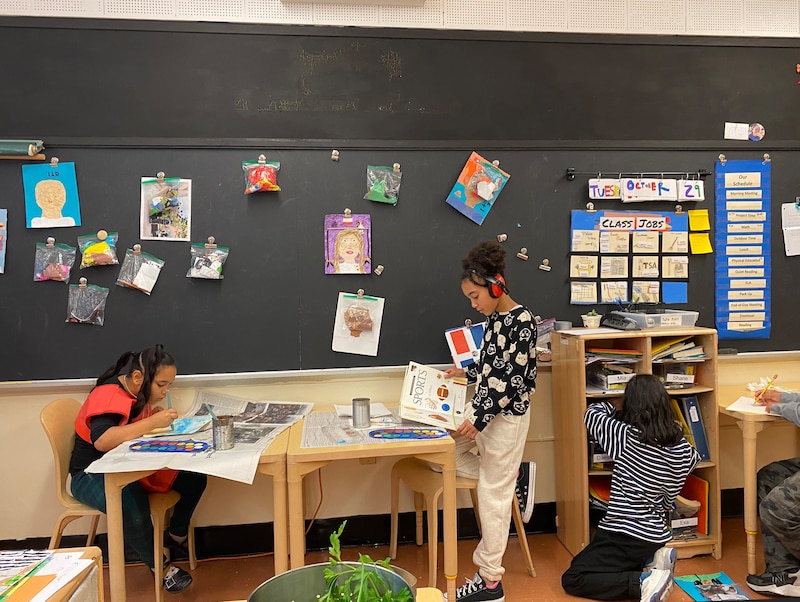
On a latest morning, a number of clusters of scholars within the blended second and third grade class had been chopping and gluing bits of development paper and different supplies for mosaic-style self-portraits. One pupil, who was fighting easy methods to depict his nostril, approached the principal.
“Gabriel, I need assistance,” the coed stated.
Feldberg grabbed a mirror, and he and the coed noticed the shapes of their noses.
“What do you see,” Feldberg requested as the 2 engaged in a prolonged dialogue concerning the variations of their nostril shapes.
College students’ self-portraits are compiled in a “recollection folder” college students obtain within the spring of fifth grade to assist them mirror on their journey as learners and the issues that they’ve been obsessed with, Feldberg stated.
“You’ll get to rediscover your youthful self and take into consideration who you’ve been,” Feldberg stated.
CPE 1 guardian Kaliris Salas-Ramirez, stated her older son, now in center faculty, “at all times felt seen” on the faculty.
A former member of town’s Panel for Instructional Coverage, Salas-Ramirez credit the college with inspiring her to change into a guardian chief. Practically a decade in the past, she helped oust a principal the Schooling Division put in on the faculty, who clashed with the neighborhood’s progressive bent. She’s proud that her sons are following swimsuit: In pre-Okay final 12 months, her youthful son’s class staged a protest for being excluded from the college’s dance lessons by means of the Alvin Ailey American Dance Theater.
“It’s actually arduous to duplicate what occurs at CPE,” she stated. “Children simply actually push themselves to assume past.”
Cultivating social-emotional studying and not using a pre-packaged curriculum
CPE 1, like many faculties throughout town, has misplaced college students in recent times. The college, which supplies precedence to college students throughout East Harlem’s District 4, is surrounded primarily by public housing with a sprinkling of recent development. Some households have been priced out of the realm, Feldberg stated.
The college is serving about 170 youngsters this 12 months, down from its goal of 186, with its pre-Okay class hit arduous by enrollment dips, the principal stated.
Although the college doesn’t use a commercially made social-emotional curriculum, Feldberg stated, CPE1 prides itself on infusing these practices all through the day. The college is deliberately small in order that staffers can know their college students nicely, and college students can know one another nicely, too.
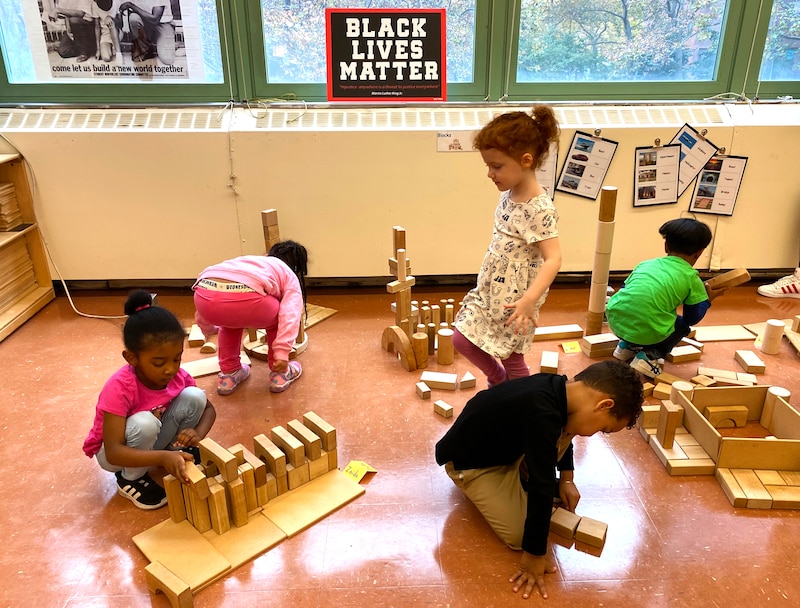
On a latest morning, a couple of dozen pre-Okay college students had been busy constructing with blocks. At first of the 12 months, youngsters work on particular person tasks earlier than they start extra advanced collaborations. The academics incorporate literacy as the kids work, with a “phrase wall” the place college students can discover phrases so as to add to their development tasks. One lady grabbed the phrase “playground,” which she then painstakingly wrote on a small piece of paper that she taped on a brick in her work space.
One other pupil, Samir, was stacking blocks to construct a excessive tower close to the wall of phrases, however as different college students walked over there, his blocks toppled over.
“Are you OK?” Marilyn Martinez, one of many academics, requested Samir.
“Everybody freeze,” she stated to the category. “Can we establish what the issue is?”
“They knocked down the blocks,” one lady stated.
“They knocked down the blocks,” Martinez repeated, “however what appears to be the issue?”
Samir began crying — one of many blocks had hit him on the pinnacle as his construction collapsed. One other instructor took him to get ice from the nurse, and Martinez talked with the remainder of the group.
Martinez requested the children a sequence of questions to assist them perceive what occurred — the children received too near Samir’s tower — and the way they might “stroll safely” to and from their work areas in ways in which wouldn’t intrude with somebody’s mission.
“Samir received damage,” Martinez continued. “What can we do to assist Samir out?”
“Give him a hug,” one little one stated.
Martinez stated they might ask him if he needed a hug when he got here again, noting that he may not need one.
“What can we do proper now to assist him out?” she requested.
One pupil supplied to assist clear up his bricks. One other supplied to assist him rebuild. Martinez prompt they might help stack the bricks in neat piles to make it simpler for him to construct when he returns. Two youngsters started working.
For Feldberg, the pre-Okay development incident mirrored the college’s method to social-emotional studying. It illustrated to the children how they’re “accountable to the group,” and the way they wanted to pay attention to one another’s work and the way they might have an effect on others.
“When you’ve the expertise of pulling down somebody’s blocks,’’ he stated, “you study your interconnectedness.”
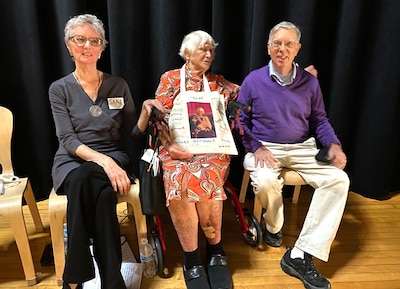
In a classroom at one other faculty, that scenario might need been dealt with a lot otherwise — and in lots much less time. However creating a way of interconnectedness and cooperation has been a throughline throughout the college’s half a century.
For Meier, the college’s basis has at all times rested on creating a way of caring for others and their neighborhood, which ties again into her notion of taking part in democracy.
“Caring is an important a part of being a great citizen,” she stated. “Accepting others, listening to others … We are able to typically disagree with somebody however nonetheless discover a few of their concepts fascinating and provocative.”
Amy Zimmer is the bureau chief for Chalkbeat New York. Contact Amy at azimmer@chalkbeat.org.

